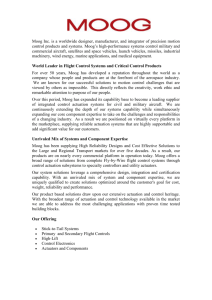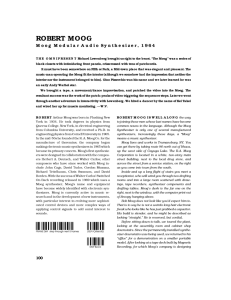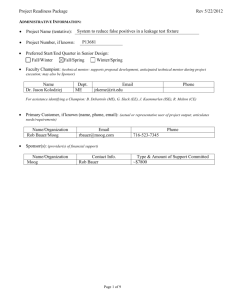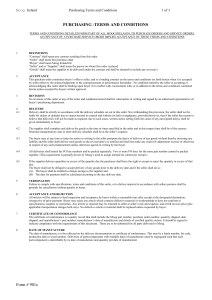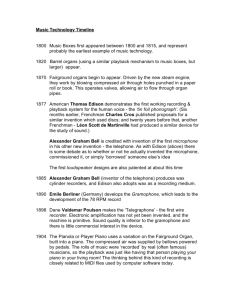In the Moog
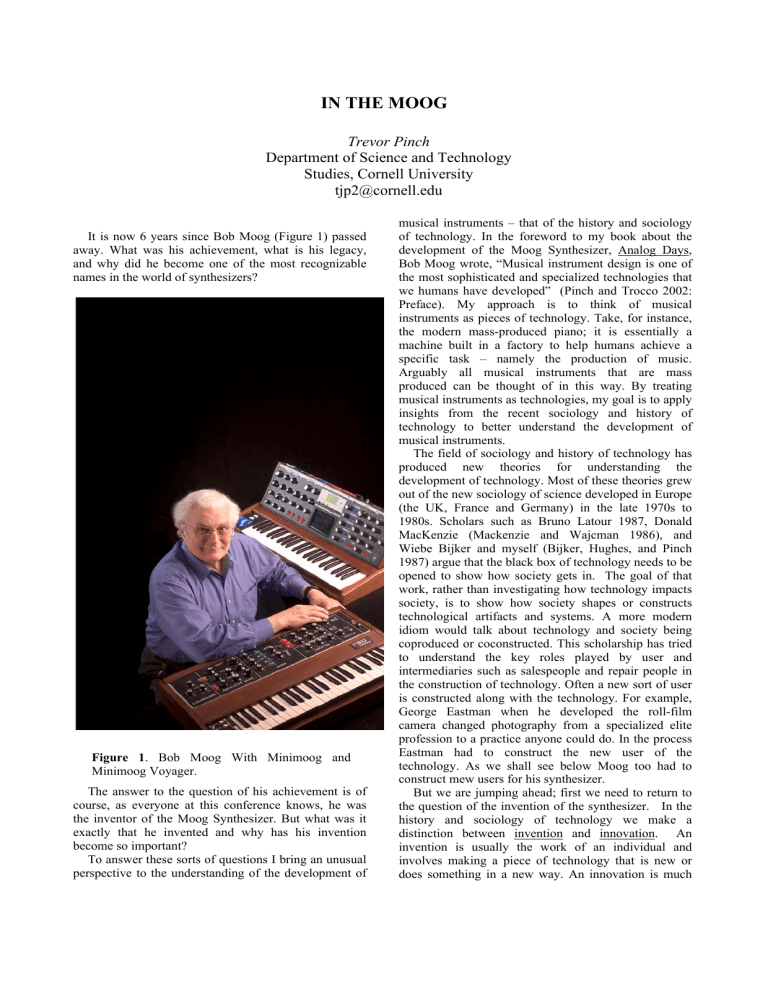
IN THE MOOG
Trevor Pinch
Department of Science and Technology
Studies, Cornell University tjp2@cornell.edu
It is now 6 years since Bob Moog (Figure 1) passed away. What was his achievement, what is his legacy, and why did he become one of the most recognizable names in the world of synthesizers?
Figure 1 . Bob Moog With Minimoog and
Minimoog Voyager.
The answer to the question of his achievement is of course, as everyone at this conference knows, he was the inventor of the Moog Synthesizer. But what was it exactly that he invented and why has his invention become so important?
To answer these sorts of questions I bring an unusual perspective to the understanding of the development of musical instruments – that of the history and sociology of technology. In the foreword to my book about the development of the Moog Synthesizer, Analog Days,
Bob Moog wrote, “Musical instrument design is one of the most sophisticated and specialized technologies that we humans have developed” (Pinch and Trocco 2002:
Preface). My approach is to think of musical instruments as pieces of technology. Take, for instance, the modern mass-produced piano; it is essentially a machine built in a factory to help humans achieve a specific task – namely the production of music.
Arguably all musical instruments that are mass produced can be thought of in this way. By treating musical instruments as technologies, my goal is to apply insights from the recent sociology and history of technology to better understand the development of musical instruments.
The field of sociology and history of technology has produced new theories for understanding the development of technology. Most of these theories grew out of the new sociology of science developed in Europe
(the UK, France and Germany) in the late 1970s to
1980s. Scholars such as Bruno Latour 1987, Donald
MacKenzie (Mackenzie and Wajcman 1986), and
Wiebe Bijker and myself (Bijker, Hughes, and Pinch
1987) argue that the black box of technology needs to be opened to show how society gets in. The goal of that work, rather than investigating how technology impacts society, is to show how society shapes or constructs technological artifacts and systems. A more modern idiom would talk about technology and society being coproduced or coconstructed. This scholarship has tried to understand the key roles played by user and intermediaries such as salespeople and repair people in the construction of technology. Often a new sort of user is constructed along with the technology. For example,
George Eastman when he developed the roll-film camera changed photography from a specialized elite profession to a practice anyone could do. In the process
Eastman had to construct the new user of the technology. As we shall see below Moog too had to construct mew users for his synthesizer.
But we are jumping ahead; first we need to return to the question of the invention of the synthesizer. In the history and sociology of technology we make a distinction between invention and innovation. An invention is usually the work of an individual and involves making a piece of technology that is new or does something in a new way. An innovation is much
wider and signifies that a piece of technology or new way of doing something, say a new process for manufacturing glass, has reached wide acceptance and uptake. If it is a consumer technology it will be available for purchase in a retail store somewhere. Bob
Moog’s modular electronic music synthesizer developed in the period 1964-1968 is difficult to characterize as either an invention or an innovation (Figure 2). This is because the modular Moog synthesizer only sold a rather small number of units (several hundred) and used technology already available – namely voltage control.
The only part of the synthesizer that was invented by
Moog and which he held a patent on was his famous low-pass filter, better known as the ladder filter. As is well known, Moog also was not alone, there were other synthesizers around at the time, and some such as the early Buchla Box, were developed at almost the same time or even earlier than the Moog (Figure 3).
Figure 2 . Mort Garson with Modular Moog
Synthesizer.
Figure 3 . Suzanne Ciani with her Buchla 200
Synthesizer.
Moog’s genius was to take off-the shelf technology, the analog transistor technology of voltage control, and adapt it to design a new sort of musical instrument which was smaller, more portable, versatile and cheaper
(transistors had dropped dramatically in price) than what was around at the time. He was extremely fortunate in the early days to have an important musical collaborator, Herb Deutsch, who, as an experimental electronic musician, could guide Moog as to exactly what sorts of sounds and interfaces would be of interest to musicians. Moog’s collaborations with partners and customers, many of whom were friends, were not a conscious effort to build a business this way but just something Moog felt was natural. As he told me:
All the people I did business with in the early days have remained collaborators and friends and customers throughout the years…They’ve been very valuable to me both as personal friendships and as guidance in refining synthesizer components-
Indeed Bob’s slightly other worldly personality, coupled with an earthy sense of humor and an ability not to take himself too seriously no doubt helped him foster good and lasting relationships with musicians. He was also helped by the piano lessons his mother insisted on him taking as a child. Moog found it harder to forge good relationships with business people which perhaps in the end led to him having to sell his first company in
1971 and thereby losing the right to use his own name for much of his career.
Moog learnt much from the musicians he worked with. For example Vladimir Ussachevsky gave him the idea for what became the ASDR envelope shaper.
Wendy Carlos first suggested that portamento would be useful to have on the keyboard (remember it was still a monophonic keyboard). Having a keyboard at all was
Moog’s idea – he hooked up an organ keyboard with a resistor chain to his first modules. Moog’s synthesizer was also controlled by knob and wires and he offered a ribbon controller to produce sweeps of sound (made from a continuous resistance strip and owing much to
Moog’s school boy business with his father, as a builder of Theremins and selling kits).
Moog developed new spaces where he could learn from his users. He not only delivered many of the synthesizers he sold himself personally (sometimes travelling with the synthesizer down to New York City on the Greyhound Bus) so he could watch musicians install them in their studios but he also constructed a studio in his factory (Figure 4). The idea for the studio stemmed from his first summer in business when he held an electronic music symposium inviting musicians to visit the factory for a couple of weeks to try out the then rudimentary gear. He later offered free tuition to musicians who visited depending on how much gear they bought, but again this was an opportunity to watch, listen and learn from his customers. When the studio wasn’t used, such as at night, Moog invited local musicians in to use the gear freely. As David Borden of
Mother Mallard who became Moog’s first studio musician, often relates, the only condition was that if they broke the equipment they had to leave everything set up exactly as it was when the malfunction occurred.
In effect the engineer’s were “idiot proofing” the synthesizers for musicians, and indeed Moog equipment is famous for its robustness and reliability. Moog not only learnt from his users but cultivated them. He employed Reynold Weidener to develop a new
magazine for the burgeoning community interested in electronic music. This magazine, Electronic Music
Review, was a precursor to the later special interest magazines such as Keyboard .
Figure 4 . Bob Moog (at front) in his
Trumansburg Factory Studio.
Moog employed a salesman in New York,
Walter Sear and two salesmen on the West Coast, Paul
Beaver and Bernie Krause. All Moog’s salespeople were themselves musicians. Moog had been particularly close to Sear as they had earlier gone into business together with an ill-fated venture making cheap guitar amplifiers. As he started to sell his first modular synthesizers Moog was given pause for thought by
Ussachevsky. Like Moog, Ussachevsky had trained as an engineer and hence was particularly influential on a young and impressionable Moog. When Ussachevsky bought identical keyboardless Buchla synthesizers for the Princeton and Columbia electronic music studios
Moog fretted. Ussachevsky had told him that serious electronic music composers would never buy an instrument designed around a keyboard. On the other hand Moog’s sales people urged him to stay with the keyboard realizing that it was an interface with which most musicians would be familiar. The iconic status of keyboards was also something of which Bob Moog was well aware. As he told me:
The Keyboards were always there, and whenever someone wanted to take a picture, for some reason or other it looks good if you’re playing a keyboard. People understand that then you’re making music. You know
[without it] you could be tuning in Russia.
What Moog and Ussachevsky didn’t know was that the market for synthesizers was going to change drastically as new users appeared. One of these new users was Moog’s second ever customer – a commercial musician, Eric Siday, who wanted to use the synthesizer for making advertisements, jingles and the like. Siday, for example, was responsible for a famous Maxwell
House coffee ad with the electronic rendering of the sound of percolating coffee. This was a new field for electronic musicians to enter, opened up by the pioneering efforts of Siday and Raymond Scott (Taylor
2011). Later other important new uses emerged such as the use of the synthesizer in movies. “Midnight
Cowboy” was one of the first big movies to use a synthesizer for part of the music and soon its potential for special effects was realized with Star Wars being the first movie to make all special effects with a synthesizer
(an ARP 2600). Later after the success of the Miami
Vice TV series and Jan Hammer’s composition, mood music played on a synthesizer became a mainstay of TV shows.
The setting of standards is a key moment in understanding how technologies develop. Conflicts over standards also tell us much about the different groups and their interests that shape technologies. The story of the MIDI standard has never fully been written but in this earlier period Moog adopted a standard that was highly influential - the volt-per-octave standard. The other synthesizer companies of the period (EMS and
ARP) adopted a form of this standard. The only major player to reject it was Don Buchla. Since Buchla’s vision was not about conventional keyboard music it made no sense for him to adopt a standard based upon the notion of an octave. This is a powerful example of how culture and society get inside technology. Moog’s standard seems purely a technical thing, but by using octaves it also defines a piece of our culture, the sort of music that the synthesizer is best suited for. Buchla, influenced by Cage, and with a more experimental radical vision rejected the idea that this instrument should be based on what he took to be a very oldfashioned interface taken over from the organ, harpsichord, and piano.
The power of old interfaces to dictate a technology’s development is a familiar one from economic history.
The economists talk about the “path dependency” of technologies and “lock In” – they point to the
QWERTY keyboard as an example. A technology introduced a long time ago to slow typists down
(because keys on manual typewriters would stick if struck too fast) is now ubiquitous on a different technology, computers.
The biggest break of all that Moog had was the new genre of psychedelic music that took off in the late 60s.
Moog was encouraged by the first commercial hit using
an electronic instrument, the Beach Boy’s 1966, Good
Vibrations, which used Theremin. It turned out the synthesizer was perfect for the psychedelic movement who were exploring unusual new instruments, washes of sound and spacey timbres. Paradoxically it was Don
Buchla who first discovered the psychedelic potential.
He was living right in the middle of Haight Asbury and the San Francisco Tape Music center was at the center of many happenings initiated by composer Raymond
Sender. Buchla and his synth were part of The Trips festival (Figure 5) organized by Sender, Stuart Brand and Bill Graham (and attended by Steve Jobs and others who later became luminaries of Silicon Valley, Turner
2006). Buchla also built a box for Ken Kesey for his famous bus FURTHER and built synths for the Grateful
Dead. Moog synths became part of the psychedelic scene by courtesy of Beaver and Krause who were present in a booth at the fairground where the Monterey
Pops Festival was taking place. This famous 60s festival, starring Jimmy Hendrix, is widely seen as where the recording industry discovered the San
Francisco psychedelic music scene. Beaver and Krause had sounds set up on headphones and tripped out musicians armed with big record company advances, on hearing the Moog, said things ;like, “MAN we’ve gotta have THAT on our next record”. Soon the Byrds, the
Doors, the Beatles and the Stones had acquired Moogs.
The role of Moog’s salesmen again was crucial. Moog was hardly himself a tripped out hipster! With pen protector and fifties engineering values, Moog may have attended pot parties but never inhaled. Moog was happy to let Beaver and Krause “deal with the hippies” as he described it to me.
Moog as the latest gimmick, this led to more sales of modular synths. Many genres of Switched On albums were released in the aftermath of SOB including my favorite,” Switched-On-Santa” (Figure 6), but very few approached the artistry and studio skills of Wendy
Carlos. 1969 was the only year R.A. Moog of
Trumansburg ever made a profit.
Figure 5 . Buchla Synthesizer in Use During
Trips Festival.
Moog’s own vision for the synthesizer was more towards the classical music on which he had been brought up. When Wendy Carlos’s Switched-on-Bach came out in 1968, Moog had finally found an artist which fulfilled his vision for the instrument. The massive success of Switched-on-Bach, was however, a double edged sword. The recording industry treated the
Figure 6 . Switched-on-Santa.
As Moog searched for venture capital to keep his company afloat, engineers Bill Hemsath and Jim Scott worked frantically with Moog on a new instrument – the
Minimoog. Using versions of the oscillator, filter, envelope generator and noise sources found on the big modular instrument, a built in keyboard with the innovative pitch wheel and modulation wheel controls, and now hardwired with switches and no patch cords, the Minimoog was destined to become a legendary synth. Although analog it became the template for all subsequent synths. The Minimoog was a true innovation because the Moog company in partnership with charismatic salesman and former TV evangelist,
David VanKouvering, established a network of dealerships such that the Minimoog could be sold in retails music stores, first in the US and then all over the world (Figure 7). It was the first synth ever to be sold in retail music stores. At the same time keyboard virtuosos such as Keith Emerson and Rick Wakeman showed the power of the monophonic keyboard solo in rock – a sonic energy which was now widely available through the Minimoog. The new instrument was still expensive
- the price of a rock van - but it was affordable and part of the marketing and selling strategy was to attract these new young users to the instrument. At the same time other companies, such as ARP, started to offer portable keyboard synths and the rest, as they say, is history….
Figure 7 . David Van Koevering in his Moog sales office.
So Moog was a true visionary and innovator. His innovation of lasting import was, however, the minimoog. His instruments never became part of the standard orchestra, something he had hoped for once, but instead he became the legendary cult figure whose instrument transformed the world of popular music in more ways than he ever could have imagined.
BIBLIOGRAPHY:
[1] Bijker, W., T.P. Hughes and Trevor Pinch, eds.
1987, The Social Construction of Technological
Systems, Cambridge, Ma. MIT Press .
[2] Latour, Bruno, 1987, Science in Action, Cambridge
MA : Harvard University Press.
[3] MacKenzie, Donald and Judith Wajcman, 1986, The
Social Shaping of Technology, Milton Keynes: Open
University Press
[4] Pinch, Trevor, and Karin BIjsterveld, 2011, The
Oxford Handbook of Sound Studies, Oxford and
New York: Oxford University Press.
[5] Pinch, Trevor and Frank Trocco, 2002, Analog
Days: The Invention and Impact of the Moog
Synthesizer, Cambridge, MA. : Harvard University
Press.
[6] Taylor, Tim, 2011, “The Avant-garde in the Family
Room: Advertising and the Domestication of
Electronic Music in the 1960s and 1970s,” in Pinch and Bijsterveld 2011.
[7] Turner, Fred, 2006, From Counter Culture to Cyber
Culture, Chicago: The University of Chicago Press.
